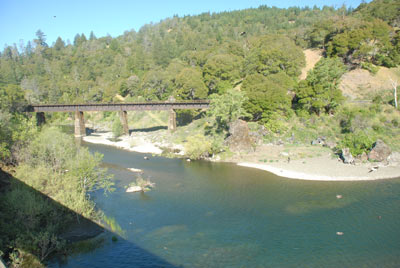Fiction: Hundreds of miles of Coho salmon habitat have been lost above Scott Dam.
The upper main stem Eel River habitat, above Outlet Creek, is not favorable to Coho salmon, which thrive in the cooler areas of rivers that are closer to the coast, such as the South Fork of the Eel River. The only place on the entire Eel River that has long term data regarding salmon and steelhead population returns is at the CDFG Van Arsdale Fish Station. Over the last 77 years, Coho salmon have been counted at the Van Arsdale Station in only three winters. In the winter of 1946-1947, forty seven Coho salmon were counted; one arrived in 2000-2001; four were counted in 2001-2002.
 Historically, Coho salmon were found in Tomki Creek below Cape Horn Dam. Today, Coho salmon still successfully spawn in Outlet Creek, which is between Cape Horn Dam and Dos Rios. In fact, the Outlet Creek run is one of the longest runs of Coho salmon known.
Historically, Coho salmon were found in Tomki Creek below Cape Horn Dam. Today, Coho salmon still successfully spawn in Outlet Creek, which is between Cape Horn Dam and Dos Rios. In fact, the Outlet Creek run is one of the longest runs of Coho salmon known.
The most frustrating aspect of comparative observations regarding the salmonid populations of the Eel River is the lack of historical data from the entire watershed. The only available data are some random years of observations at Benbow on the South Fork, a few private logging companies which kept sporadic records, and lots of presence/absence observations, besides the counts reported from the Van Arsdale Fish Station. No one knows what the historical numbers were, or even what the current fish counts are, on the Middle Fork, North Fork, South Fork or Van Duzen Rivers. Most of these forks of the Eel River have more volume, and even have tributaries nearly as big as the Mainstem Eel where the Potter Valley Project is located. It is interesting to note that, in the first 24 years after Scott Dam was built, no Coho salmon were counted at the Van Arsdale Fish Station. If Coho Salmon had been spawning in the upper reaches of the Mainstem Eel River why didn't any of them try to return to those tributaries in the years following construction of Scott Dam? Certainly Chinook and steelhead continued to return.
 Historically, Coho salmon were found in Tomki Creek below Cape Horn Dam. Today, Coho salmon still successfully spawn in Outlet Creek, which is between Cape Horn Dam and Dos Rios. In fact, the Outlet Creek run is one of the longest runs of Coho salmon known.
Historically, Coho salmon were found in Tomki Creek below Cape Horn Dam. Today, Coho salmon still successfully spawn in Outlet Creek, which is between Cape Horn Dam and Dos Rios. In fact, the Outlet Creek run is one of the longest runs of Coho salmon known.